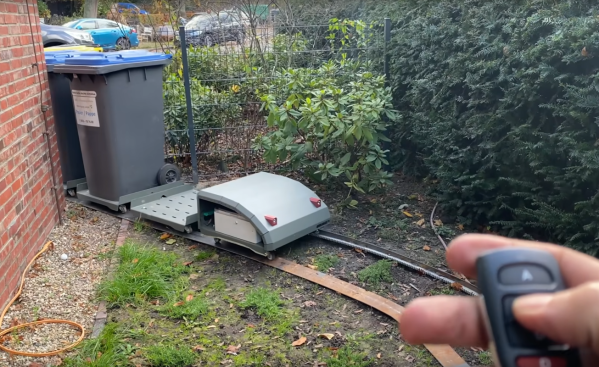By now it’s probable that most readers will have heard about LastPass’s “Security Incident“, in which users’ password vaults were lifted from their servers. We’re told that the vaults are encrypted such that they’re of little use to anyone without futuristic computing power and a lot of time, but the damage is still done and I for one am glad that I wasn’t a subscriber to their service. But perhaps the debacle serves a very good purpose for all of us, in that it affords a much-needed opportunity for a look at the way we do passwords. Continue reading “The Problem With Passwords”
2022: As The Hardware World Turns
Well folks, we made it through another one. While it would be a stretch to call 2022 a good year for those of us in the hacking and making community, the light at the end of the tunnel does seem decidedly brighter now than it did this time 365 days ago. It might even be safe to show some legitimate optimism for the year ahead, but then again I was counting on my Tesla stocks to be a long-term investment, so what the hell do I know about predicting the future.

Thankfully hindsight always affords us a bit of wisdom, deservedly or otherwise. Now that 2022 is officially in the rearview mirror, it’s a good time to look back on the highs (and lows) of the last twelve months. Good or bad, these are the stories that will stick out in our collective minds when we think back on this period of our lives.
Oh sure, some might wish they could take the Men in Black route and forget these last few years ever happened, but it doesn’t work that way. In fact, given the tumultuous times we’re currently living in, it seems more likely than not that at some point we’ll find ourselves having to explain the whole thing to some future generation as they stare up at us wide-eyed around a roaring fire. Though with the way this timeline is going, the source of said fire might be the smoldering remains of an overturned urban assault robot that you just destroyed.
So while it’s still fresh in our minds, and before 2023 has a chance to impose any new disasters on us, let’s take a trip back through some of the biggest stories and themes of the last year.
Holographic Cellphones Coming Thanks To AI
Issac Asimov foresaw 3D virtual meetings but gave them the awkward name “tridimensional personification.” While you could almost do this now with VR headsets and 3D cameras, it would be awkward at best. It is easy to envision conference rooms full of computer equipment and scanners, but an MIT student has a method that may do away with all that by using machine learning to simplify hologram generation.
As usual, though, the popular press may be carried away a little bit. The key breakthrough here is that you can use TensorFlow to generate real-time holograms at a few frames per second using consumer-grade processing power found in a high-end phone from images with depth information, which is also available on some phones. There’s still the problem of displaying the hologram on the other side, which your phone can’t do. So any implication that you’ll download an app that enables holograms phone calls is hyperbole and images of this are in the realm of photoshop.
Continue reading “Holographic Cellphones Coming Thanks To AI”
What’s New, From 1927
Here we are at the start of the new year, which for the Internet Archive means a note about what has just entered the public domain. 1927’s finest previously copyrighted materials are now up for grabs in the public domain, which means there’s a treasure trove of films, books, and music to freely copy and remix.
Their article highlights a few notable pieces of 1927’s popular culture , of which we suggest you should definitely take note of Fritz Lang’s Metropolis if you have any interest in sci-fi, but for Hackaday readers there’s not much else in the article itself relating to technology. Delving into the archive for 1927 is still a fascinating pastime though, because beyond the interest of seeing what’s now free it led onto what was the state of technology in the 1920s. And here we find ourselves as much navigating the English language as we do the library itself, because so much of what we do uses vocabulary from the decades since. Continue reading “What’s New, From 1927”
All Aboard The Garbage Express
Cog railways are a somewhat unusual way of train locomotion, typically only installed when a train needs to climb steep terrain. Any grade above about 10% needs the extra traction since the friction between the wheels and rails won’t be enough to push the train forward or keep it from falling backwards. Even without a steep hill to climb, sometimes a cog railway is necessary for traction as [Max Maker] discovered while building a train for his garbage cans.
The build started out as a way to avoid having to wheel his seven waste bins to the curb every month. Originally he built a more standard railway with a simple motor to drive the train, but he quickly realized that there wasn’t enough grip even when using plastic wheels, even though this track follows fairly flat terrain. Since the rail is built out of steel he quickly welded up a rack-and-pinion system to one of the rails. The build goes through many iterations before he finally settles on a design that solves the problem, and it includes several other features as well such as remote control and a spring-loaded automatic charger for the train at its station in the back yard.
While we always appreciate the eccentricity of those who would automate a relatively simple task that only happens once a month, [Max Maker] hopes to build this into a commercial product aimed at the elderly or disabled who would really benefit from a reliable, semi-automatic system that takes their trash bins to the curb for them. And, if your system only involves a single trash can, there are other ways of automating the task of taking the garbage to the curb.
Generative Music Created In Minimalistic Javascript Code
Dittytoy user [srtuss] has recreated one of the most influential works of electronic music in an elegant nineteen kilobytes of Javascript code. The recreation of Jean-Michel Jarre’s Oxygene Part IV on the Dittytoy platform, currently in beta, plays live right in your browser. Dittytoy empowers users to create generative music online using a simple Javascript API. Syntax of the API is loosely based on that of Sonic Pi, a code-based music creation and performance tool.
“Oxygene (Part IV)” was recorded by Jean-Michel Jarre in 1976. It was Jarre’s most successful single, charted on the top ten in several countries, and was more recently featured in the Grand Theft Auto IV video game. In the 1990s, famed electronic music innovator Brian Eno used the term “generative music” to describe music generated by an electronic system comprising ever-changing elements that may be algorithmic or random.
Recreation of Jarre’s work required modeling the Korg Minipops 7 drum machine, one of the instruments presented in our slew of open-source synthesizers.
Snow Plowing By Bicycle
There are few challenges more difficult or dangerous than trying to get around the majority of North American cities by bicycle. Not only is the bicycle infrastructure woefully inadequate for safe travel (if it exists at all), but it’s often not maintained to any reasonable standard, either. This goes double in colder areas, where bike paths can essentially become abandoned in the winter after a snowfall. [Phil] found himself in this situation recently after a snowfall in western Canada and decided to DIY his own bike-powered snowplow to help keep his bike paths cleared.
The plow is built around an electric-assisted cargo bicycle, which is almost as rare in North America as bicycle infrastructure itself, but is uniquely suited to snowplow duty. It has a long wheelbase and a large front cargo area that can be weighed down if needed to ensure the plow makes good contact with the ground. The plow itself is built out of sections of plastic 55-gallon drums, which have been cut into two scooping sections and attached to the bike with a wooden 2×4 frame. The plow can be raised or lowered with a ratchet strap mechanism, and the plastic scoop skips over bumps in the path with relative ease.
With this relatively simple mechanism attached to his bike, [Phil] can make sure the trails that he frequents around Vancouver are more suitable for bike travel in the winter. Riding a bicycle through the winter, even in the coldest of climates, is not that difficult with the right support and investment in infrastructure, and this build is the best DIY solution we’ve seen to bicycle infrastructure support outside of adopting something like this remote-controlled snowblower to the job.


















